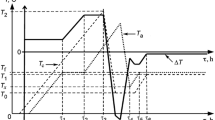The occurrence of an error due to the thermoelectric inhomogeneity of thermocouple electrodes, acquired during prolonged use, is considered, and the properties of this error are formulated. A mathematical model of the error of chromel and alumel electrodes is constructed, the error in measuring the temperature is estimated, and the most dangerous mode of operation of the thermocouples is revealed.



Similar content being viewed by others
References
GOST R 8.585–2001 GSI. Thermocouples. Nominal Static Conversion Characteristics.
IEC 60584-2-am1 (1989-06), Amend. 1. Thermocouples. Pt. 2. Tolerances Maintenance Result Date (2012).
N. A. Rogelberg et al., “Changes in the thermoelectric EMF of wires of chromel and alumel when heated in air at 800°C for up to 10000 hours. Vol. III. Investigations of alloys for thermocouples,” Trudy Inst. Giprotsvetmetobrabotka, Metallurgiya, Moscow (1969).
L. Kortvelyessy, Thermoelement Praxis, Vulkan–Verlag, Essen (1981).
GOST R 8.338–2002, GSI. Thermoelectric Transducers. Checking Procedure.
A. V. Korzhavin, V. A. Korzhavin, and V. V. Bogatov, Patent No. 2325622 RF, “A method of monitoring the reliability of the readings of a thermoelectric transducer during use,” Izobret. Polezn. Modeli, No. 15 (2008).
A. Hundves and H. G. Buschfort, Patent No. 3.499.340 USA, “Self-calibrating temperature sensing probe and probe-indicator combination.”
A. A. Sachenko, V. Yu. Mil’chenko, and V. V. Kochan, The Measurements of Temperature with Sensors with Built-In Calibrators, Energoatomizdat, Moscow (1986).
A. G. Ivanova and S. F. Gerasimov, “Fixed point based on a Ga–In eutectic alloy for the express monitoring of thermometers and temperature measurement systems,” Izmer. Tekhn., No. 5, 26–30 (2008); Measur. Techn., 51, No. 5, 498–502 (2008).
M. K. Sakharov, “The use of fixed points based on metal-carbon eutectic alloys to increase the accuracy of measurements in the temperature range above 1357.77 K,” Izmer. Tekhn., No. 2, 51–54 (2007); Measur. Techn., 50, No. 2, 179–183 (2007).
A. Sachenko, V. Kochan, and V. Turchenko, “Sensor drift prediction using neural network,” Proc. Int. Workshop on Virtual and Intelligent Measurement Systems VIMS’2000, Annapolis, USA (2000), pp. 88–92.
I. I. Kirenkov, “Some laws of thermoelectric inhomogeneity,” Research in Temperature Measurements: Trudy Inst. Komit. Stand., Mer i Izmer. Priborov (1976), Iss. 17 (231), pp. 11–15.
K. G. Sloneker, “Thermocouple inhomogeneity,” Ceramic Industry, 159, No. 4, 13–18 (2009).
T. J. Quinn, Temperature, Acad. Press, London (1983).
Author information
Authors and Affiliations
Corresponding author
Additional information
Translated from Izmeritel’naya Tekhnika, No. 10, pp. 38–42, October, 2014.
Rights and permissions
About this article
Cite this article
Jun, S., Kochan, O. The Mechanism of the Occurrence of Acquired Thermoelectric Inhomogeneity of Thermocouples and its Effect on the Result of Temperature Measurement. Meas Tech 57, 1160–1166 (2015). https://doi.org/10.1007/s11018-015-0596-3
Received:
Published:
Issue Date:
DOI: https://doi.org/10.1007/s11018-015-0596-3




